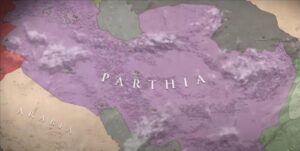
The Parthian Empire, one of the most renowned yet least-understood empires in world history, rose from humble beginnings to become a formidable force that challenged the might of Rome and the Seleukids. This empire was not only known for its martial prowess but also for its diplomatic acumen and administrative expertise. The Parthians managed to create a unique empire that blended their nomadic roots with the Hellenism of their Seleukid forebears and the traditions of Persia.
The Rise of Parthia
The Parthian tide began to rise in 209 BCE when Antiochos III defeated the Parthians in battle, making them his vassals. However, this allegiance was short-lived, and the Parthians soon broke free and started to grow once more. The small Parthian state saw its first significant expansion under Mehrbad I (or Mithridates I), who assumed the old Achaemenid title of King of Kings on his coinage.
Between 160 – 140 BCE, Mehrbad I initiated a lightning campaign against the Seleukid Empire, resulting in massive conquests in Media, Babylon, and Seleukia on the Tigris. These newly annexed territories would later become core territories of the Parthian Empire. However, at the onset, Parthian control of these lands was tenuous. The locals in these cosmopolitan, city-dense regions had a very urban-centric view of nomadic peoples, considering them to be underdeveloped baboons.
Parthian Struggles and Expansion
The Parthians faced numerous challenges in maintaining their empire. Rebellions broke out in the western provinces, including in the Arab kingdom of Charecene. The Parthians were learning that conquering land was one thing, but defending and holding it was another.
Despite these challenges, the Parthians continued to expand. Gondophares, a rebel leader, declared independence and established his own dynasty, the so-called Indo-Parthian kingdom. He fought the Indo-Scythians and Indo-Greeks in the east and took control of parts of Gandhara and Bactria.
Parthia and Rome
It was only in the 2nd Century CE that the Romans began to make incursions inside Parthia. Trajan, a Roman Emperor, initiated an invasion of Parthia in 115 CE. The campaign resulted in the maximum ever extent of the Roman Empire, as well as the fall of Ctesiphon, Parthia’s capital. However, this victory was unstable, and the Parthians quickly regained many of these territories.
Over the 1st Century CE, many wars between Rome and Parthia were fought in Mesopotamia, inflicting horrors upon the locals and resulting in some territorial changes. The Romans were also capable of fomenting rebellions in Parthia’s decentralised provinces, which exercised considerable self-rule.
The Fall of Parthia
The Parthian Empire eventually fell, becoming a rump state until they were finally annexed by Pompey and the Romans in 63 BCE. Despite their fall, the Parthians left a lasting legacy, adopting a lot from their Seleukid forebears, emulating their ruler cults and uses of the Achaemenid royal vocabulary to ensure their rule was adapted to local circumstances.
In conclusion, the rise and fall of the Parthian Empire is a tale of resilience, expansion, and struggle. Despite their eventual fall, the Parthians left an indelible mark on history, creating a unique state that was a crossroads of Eurasia and the Silk Roads.